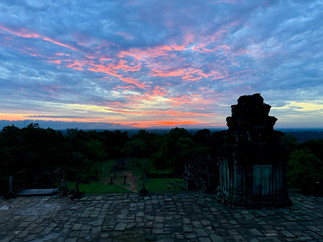A little background before I jump into our very full day of temple touring: the Khmer Empire was the ancient reigning kingdom in Southeast Asia, ruling over the entire Mekong valley from its capital city at Angkor. It reached its peak of power in the 11th century and began battling against Thai conquests as early as the 12th century before being fully destroyed by the 14th century.
Our very long, packed day of temple visits began with a 4:30 am departure and trek to see the sunrise atop Bakheng Hill, an ancient temple high above the city. While our alarm came way too early, it was absolutely worth the early rise to experience this hike up the steep hill in the dark. The payoff was tremendous – we reached the peak, about 65 meters above the surrounding land, just as the sun began to rise. The skies in front of us unfolded the most beautiful display of colors. It was awe-inspiring!
Bakheng Hill was constructed sometime between the late 9th and early 10th century and was a pyramid-style temple with seven levels to represent the seven heavens of Mount Meru, the mythological home of the Hindu gods. Its service as an active temple was short-lived, however, as it was abandoned within a few decades of its completion. Its unique location and sweeping views – including the sight of Angkor Wat in the distance – make it a must-visit historical stop.
After making our way back down the hill – this time with the aid of daylight, we proceeded to the expansive moat surrounding Angkor Thom for a relaxing gondola ride. The moat is very shallow, but it runs the full seven-mile perimeter of the temple complex. The ride was both serene and picturesque, with the most vibrant water lilies springing up everywhere! Locals pick the flowers and sell them or place them as offerings at the nearby temples. There are a couple of uses for their long, flexible stems. Locals make necklaces out of them; others consider the stems a delicacy and will skin, cook, and eat them.
The next morning stop was to one of the four main entrances to Angkor Thom. Angkor Thom was the last capital city of the Khmer Empire. The four entrances – facing North, South, East, and West – created a fortified wall around the city, which once housed religious leaders, the military, the royal residence, administrative buildings, and other residences for its citizens. Little remains of the interior buildings, as most of them were made from wood, not stone.
Much of the stone entrances still stand, including the remnants of dozens of statues lining the walkway to each entrance. There were 108 statues in total: 54 gods on the left and 54 demons on the right, signifying the struggle between good and evil. Angkor Wat, which we visited the prior day, was considered a part of Angkor Thom.
We walked the expansive space where the temple complex once stood and met our driver at an opposite gate. We then enjoyed breakfast in an open-air pavilion near the main entrance to the nearby Angkor Wat.
Afterward, we continued to Bayon Temple. Located at the center of Angkor Thom, Bayon was built in the early 13th century by Jayavarman, king of the Khmer Empire and the first devout Buddhist to rule. He built Bayon as a monument to Buddhism. Originally, there were 54 towers, one representing each of the 54 provinces of the Khmer Empire, and 37 still stand today.
The most unique aspect of this temple complex is the presence of massive carved faces. There’s disagreement on who the faces represent; they are believed to depict Jayavarman himself or Bodhisattva, someone on the Buddhist path to enlightenment. Others believe they represent the four “faces” of Buddha – loving kindness, compassion, equanimity, and sympathetic joy. In addition to giant stone faces greeting you from above at every turn, there are also numerous carvings that illustrate the everyday life of the Khmer people, as well as numerous carvings of Apsara.
The temple was originally named “Jayagiri,” meaning “victory mountain,” but was renamed Banyon Temple due to the religious significance of banyan trees to Buddhists and the presence of these trees throughout the complex. Some claim that Buddha sat under a banyan tree for seven days and, as a result, found enlightenment. However, decades later, a local Khmer mispronounced the name while working on the temple restoration, and the name “Bayon” stuck!
Monkeys scampered all over the Bayon Temple complex. We were fascinated by a group of women tediously hand-cutting the grass surrounding the complex with large hand blades. Our guide explained that locals volunteer to do this to show respect for the site.
The final stop of our incredibly full day was Ta Prohm, a much smaller temple complex built in the late 1100s and served as a Buddhist monastery and university. After it was abandoned, the silk and strangler fig trees of the Cambodian jungle devoured it. The roots of the trees loosened the temple’s stones and weaved their way through its structure. The result is a wild display of nature clashing with this ancient architecture. Because of its visually unique and interesting ruins, the movie Lara Croft: Tomb Raider was filmed in Ta Prohm.
Walking along a perimeter wall covered with moss and clover, I spotted this massive centipede!
About two-thirds of the way through this final tour, I hit my figurative brick wall! The early morning start and the amount of walking, visual stimulation, and information overload, not to mention the oppressive heat, and I was simply templed out! Or, as Karen, Bryan, and I said, as we returned to the air-conditioned refuge of our tour bus, we went from Angkor Wat to Angkor Hot to Angkor Not!
After showers and a much-needed nap, we were treated to Apsara dancers, who entertained us with four traditional dances. Our last evening in Siem Reap ended with a lovely dinner at Mahob Restaurant.




















































































ความคิดเห็น